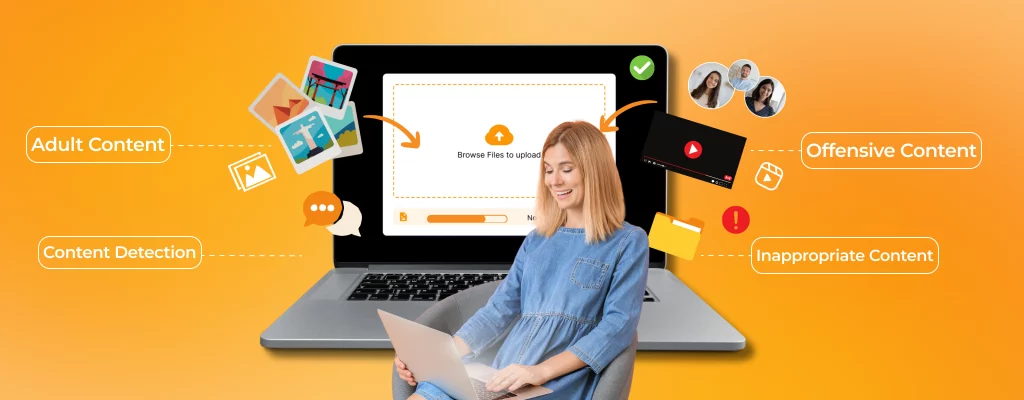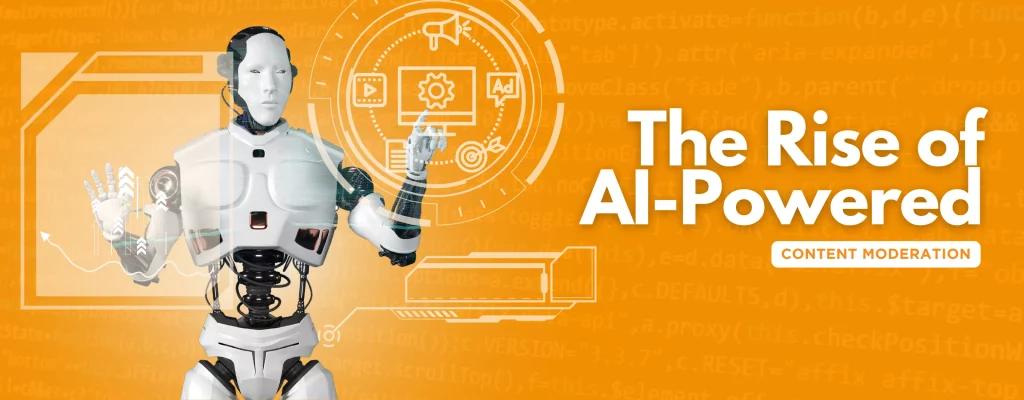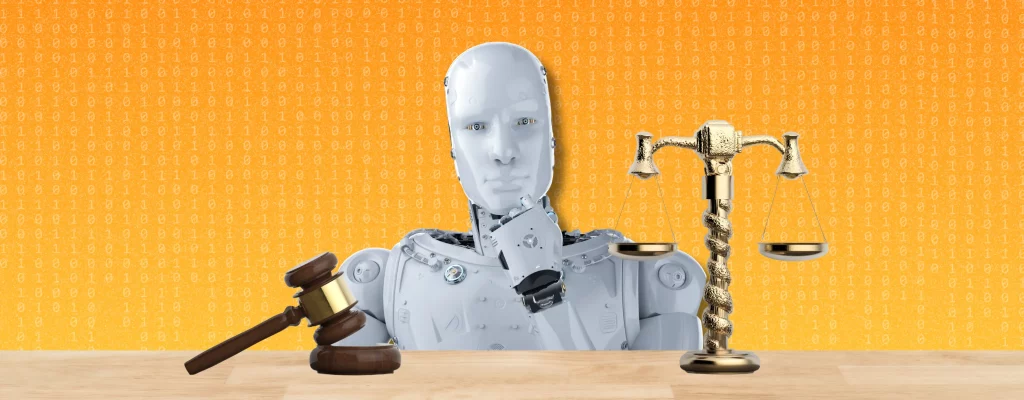How AI Moderation is Transforming Social Media Content Management

UPDATED March 1, 2024
Written By Laniel Arive
If destiny ever exists, then it must be to explain how artificial intelligence (AI) and social media are a perfect fit.
Social media can be an avenue for friendship and marketing campaigns on the one hand and a breeding ground for misinformation on the other. This duality, not to mention the vast growth of social media users across the globe, has made it difficult for humans to manage the social media landscape.
But talking about a match made in heaven, AI comes to the rescue. It birthed the possibility for AI moderation which has since revolutionized how to manage social media content.
Traditional Approaches to Content Moderation

Before the advent of AI technologies, social media moderation was done manually by social media content managers.
What is a social media content manager? How does it differ from a social media content moderator?
While “manager” and “moderator” are often used interchangeably, these job titles have different responsibilities. Social media content managers are the people behind the rich tapestry of social media platforms. Their task is to oversee the direction of the social media platform, and they manage the brand’s social media presence by planning and producing content.
On the other hand, social media content moderators are sharp eyes looking into content circulating across social media platforms. Their main task is to review and monitor user-generated content (UGC) that goes against community guidelines. These guidelines refer to the policies that a platform implements concerning prohibited content, data privacy, cultural sensitivity, and more.
With social media content managers and moderators working side by side, manual moderation has offered accurate, not to mention ethical, moderation outcomes. However, the continuous evolution of social media has birthed responsibilities beyond human capacity.
Presently, 61% of the world’s population uses social media. In number, this translates to 4.95 billion social media users across the globe who generate a sheer volume of content daily. Since online data has become unmanageable for human moderators, social media platforms resorted to AI-powered content moderation.
The Rise of AI-Powered Content Moderation

The integration of AI in social media moderation has addressed the limitations of human capacity. It embraced the changes in the social media landscape and performed what social media moderators do and more.
While the rapid progress of digital technology heavily challenged humans, AI has improved content moderation in terms of the following:
- Scalability
AI content moderation addressed the needs of an ever-expanding digital landscape. It efficiently manages vast amounts of data without needing a proportional human input. In short, AI technologies allow platforms to monitor various types of content at scale.
- Speed
AI moderation enabled the handling and screening of enormous amounts of data at incredible speed. Without moderation, social media content is inclined to proliferate misinformation, hate speech, discrimination, violence, and more. Thus, automated content moderation is crucial to monitor potentially harmful content in real-time to ensure a digital space for all users.
- Cost-Effectiveness
AI-powered content moderation offers cost savings by efficiently handling large amounts of UGC with minimal human input. It is also a cost-effective alternative for companies that seek outsourced moderators whose fees are based on content volume.
- Mitigating Psychological Effects
Human content moderators are frontliners who seek to fight the prevalence of harmful content on social media platforms. They are exposed to appalling content, such as hate speech or explicit content depicting abuse and violence, which may take a toll on their mental health. However, because AI moderation automatically reviews content, it reduces the exposure of human moderators to harmful content.
More so, AI tools can automate the flagging of offensive and explicit content. Thus, AI moderation can take them down before reaching the user interface.
Key Components of AI Moderation Systems

Just as technology has seeped into all aspects of our lives, AI has also revolutionized how to manage social media content. Below are the critical components of the AI moderation system, particularly AI technologies, which power the possibility of efficient automated content moderation.
- Natural Language Processing (NLP)
NLP allowed for the comprehension and even generation of human language. This technology understands written and spoken words in closely the same way as humans. Thus, AI could read and flag potentially harmful content in the text and chat format.
- Machine Learning (ML)
Machine learning refers to the capacity of technology to mimic human intelligence.
How does it work?
AI systems are exposed to large datasets to analyze algorithms and recognize content patterns. AI then utilizes what it has “learned” to automatically detect and categorize inappropriate content. It also uses this data training to provide predictions or content related or similar to what users engage with.
- AI algorithms
AI algorithms refer to the instructions that enable machines to perform the task of content moderation. Because these algorithms are trained on large datasets, they can access vast amounts of user data, such as browsing history, preferences, and social interaction. This helps the social media platforms tailor highly personalized content for their users, boosting the user experience and engagement.
- Reporting and Feedback mechanisms
The advances in technology are not without loopholes that need fixing. AI tools and technologies may pose inconsistencies when exposed to new or complex data. This often applies to content that relies on specific contexts such as cultural, religious, and others. Thus, implementing report and feedback mechanisms is essential.
A report option allows users to appeal the decision of content moderation, while feedback allows them to communicate the reason behind their actions. These mechanisms, which often come hand in hand, help refine the accuracy of AI content moderation and ensure the inclusivity of users.
Using AI in Social Media Moderation

Now, you must be curious about how to manage social media content for small businesses using AI. Or, more frankly, how does all this apply to me?
But before we delve into that, let us take a look first at how big social media platforms used AI content moderation to their full potential:
- Facebook and YouTube use AI algorithms to flag and remove contents that pose harm and violate their community guidelines.
- In Instagram, AI is mainly used to identify offensive and explicit visuals, such as content depicting nudity, abuse, and others.
- Netflix and Amazon employ AI content moderation to recommend products and content to users.
- LinkedIn uses AI to offer job recommendations and feed its audience the posts they might like to see.
In short, AI moderation does not end in detecting and removing offensive content. It also gives social media marketing superpowers.
But how?
AI algorithms read the pulse of the customers. It gauges what captures the attention of the audience and what drives high reach and engagement. Simply put, AI makes sense of the vast data in social media platforms and identifies which content is valuable to the users.
Ethical and Societal Implications

Unfortunately, every coin has two sides.
While AI is a big help in keeping up with technological development, on the one hand, it is a subject of ethical debate on the other. Here are the usual points of discussion surrounding the ethical complexities of using AI in content moderation:
- Privacy Issues
Because AI algorithms train on datasets, they need access to a wide array of user data. Thus, it raises questions on how these data are stored, who has access to them, and how they are used. Another potential risk is a data breach when the server suffers a cyberattack.
- Censorship
Content moderation censorship occurs when legitimate and appropriate content is flagged otherwise. Because AI algorithms do not have a mind of their own, they rely solely on the patterns they learned. Unfortunately, this makes them prone to misidentifying acceptable content as offensive. And when appropriate content is mistakenly shut down, this poses a potential infringement of the freedom of speech.
- False Positives and False Negatives
AI moderation is limited to reading content in black and white. Thus, it cannot navigate the contexts where the content is situated. This limitation makes it vulnerable to generating inaccurate moderation results, specifically false positives and false negatives. False positive occurs when harmless content is removed, while false negative is when harmful content is not detected.
- Algorithmic Bias
AI content moderation is vulnerable to inaccuracy when exposed to biased or unrepresentative content. These algorithmic biases can manifest in different forms, such as racial, gender, or ideological biases, leading to unfair moderation decisions.
Solving the AI Conundrum

The question now is, how do we address these AI content moderation problems?
While there are no standard solutions to navigate the ethical challenges of AI moderation, here are some pointers that social media platforms can do to mitigate its potential risks:
- Establish Ethical Guidelines
Although no industry-wide ethical guidelines exist, companies must be transparent in their moderation policies. These should detail their moderation processes, community standards, and prohibited content. Social media platforms must also provide accessible fields where users can clarify actions or appeal decisions.
- Give Users Control
Social media users must be allowed to consent to digital platforms using their data. Users must know when their data is being used and for what purpose.
- Invest in Quality Data Training
Social media moderators must scrutinize the datasets where AI algorithms are built to guarantee that they are diverse and unbiased. These datasets must represent different perspectives to help address the potential bias of AI moderation.
Advancements and Future Directions

The impact of AI in social media content moderation is undeniable. However, the limitations above show that AI's future in content moderation still has a long way to go. This also addresses the question of whether or not AI will ever replace humans.
Apparently, no.
However, the present study aimed to enhance AI promises a different future for content moderation. For instance, context-aware filtering technology enables a system to understand context information. This will advance the contextual detection of AI and reduce AI inaccuracy in flagging potentially harmful content. It will also address the incapacity of automated tools to generate content judgments, thus relying on human moderators to sort this subjectivity.
Summarily, the trajectory of AI in dominating the content moderation processes is not an impossibility. But until the technology has ironed it out completely, the only solution is to utilize AI and manual moderation for the best results.
Two is Better Than One

Proven already, integrating AI technologies drastically improved the social media moderation process. It aided manual moderation's limitations in handling the sheer volume of UGC on social media platforms.
More so, it intelligently recognizes content patterns which enables it to automatically flag potentially damaging content. However, human oversight remains essential to reduce potential biases and inaccurate moderation decisions the AI systems might make.
Simply put, since manual moderation and AI moderation cannot stand alone independently, the wisest decision is to employ them together. However, it is not as simple as it sounds. AI technologies must be trained properly with quality datasets, while human moderators must understand multiple languages, cultures, and nuances. And when these complexities are too much for a single company, the next wisest decision is to find a partner to do it for you.
Chekkee offers social media moderation services that apply the best of both worlds. We have skilled social media moderators competent in handling all types of UGC. Not only that, we also employ AI-powered social media moderation which works around the clock to remove harmful content and uphold user safety.
With AI assistance in manual moderation, Chekkee thoroughly monitors content on social media pages 24/7, which is a key factor for a social media platform to thrive.If you’re looking for the perfect plus one, contact us!